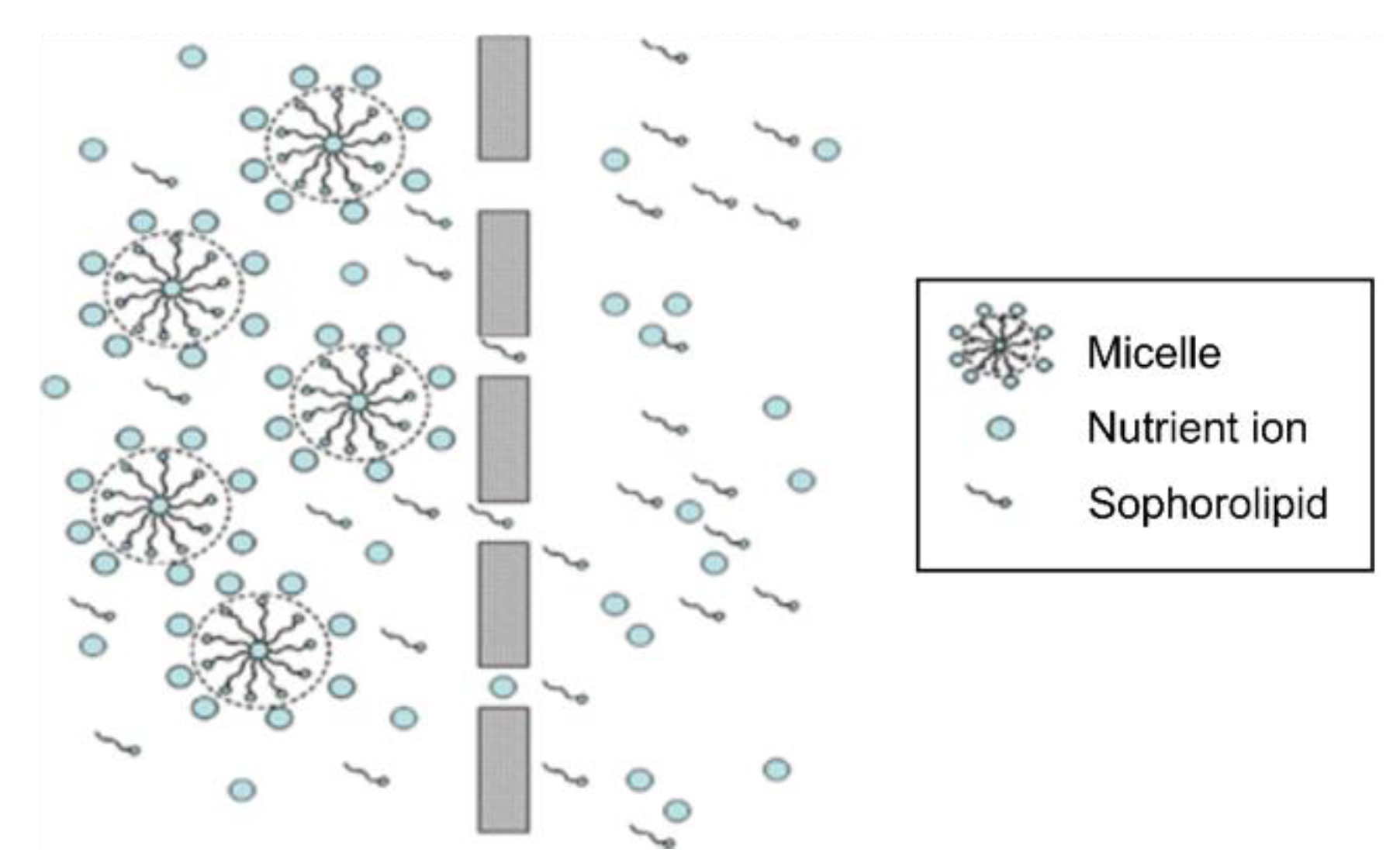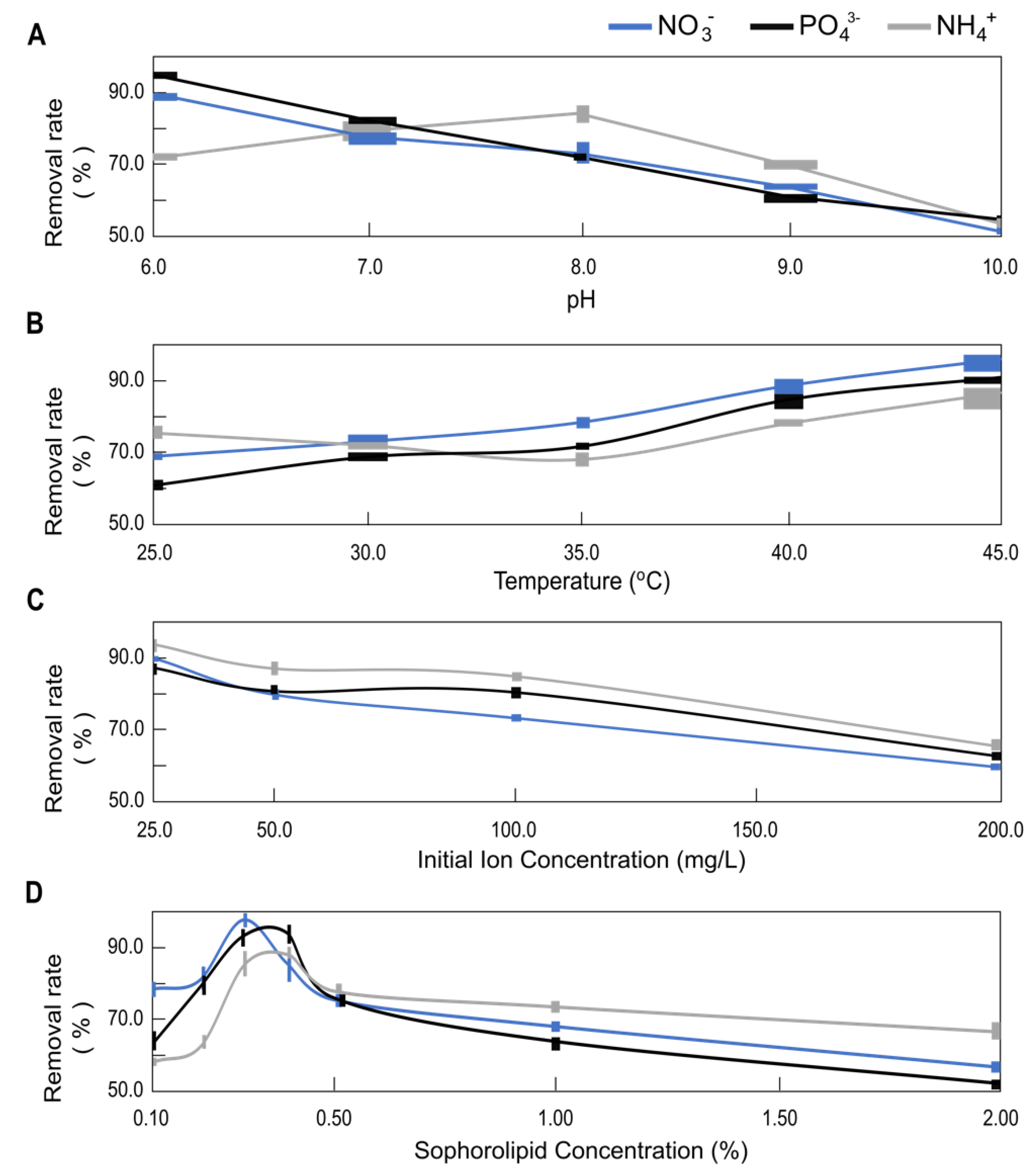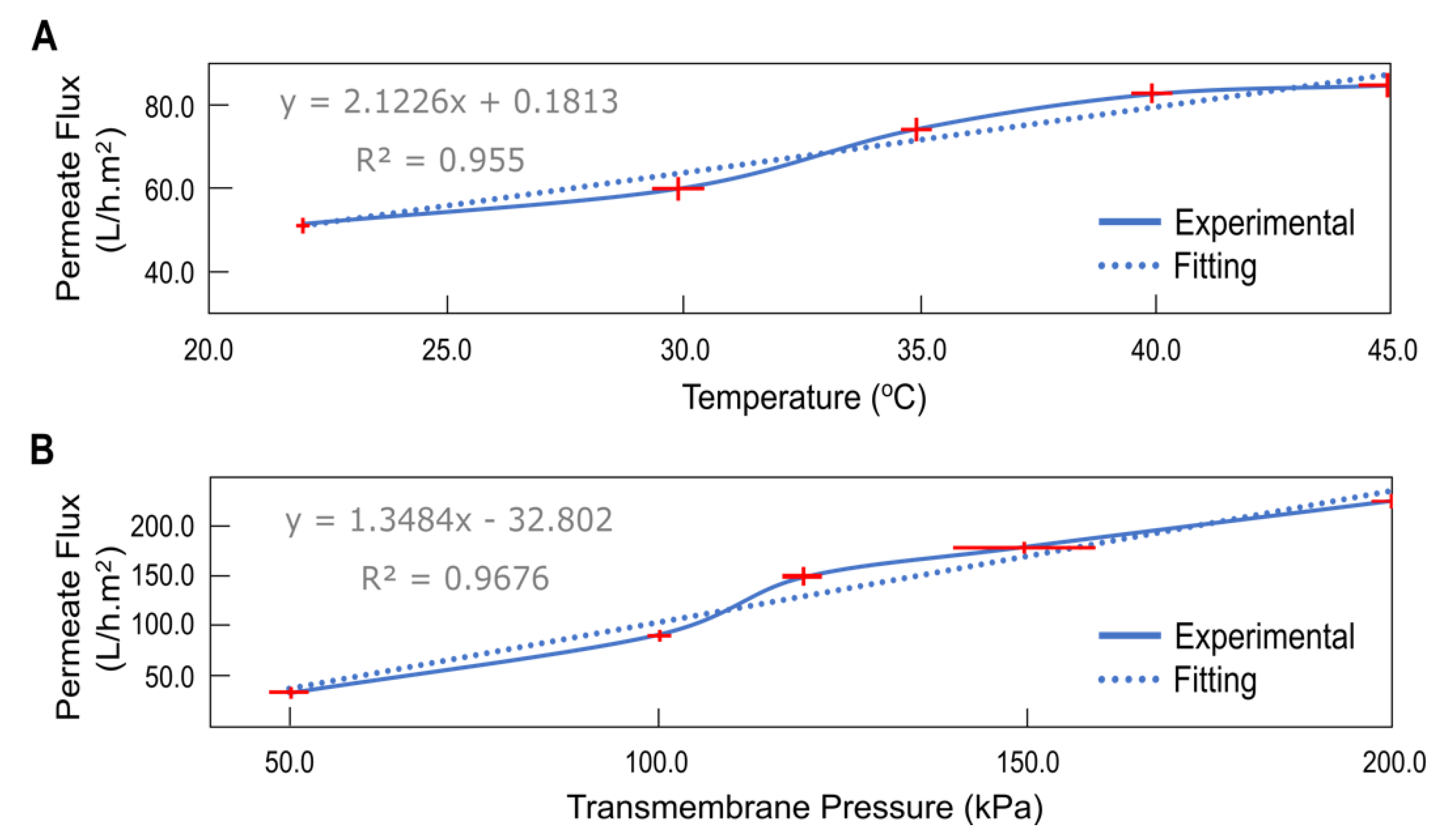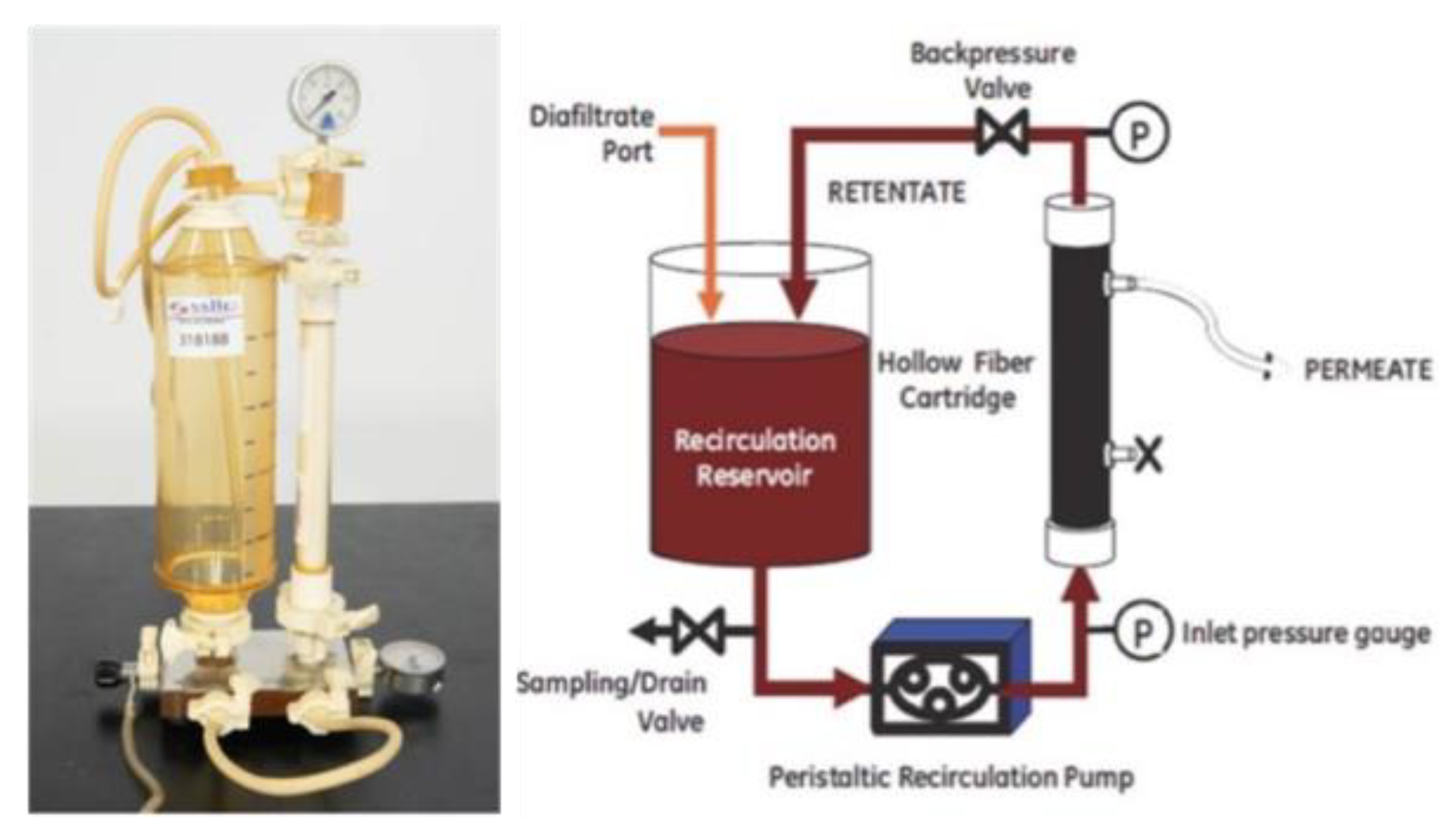Removal of Nutrients from Water Using Biosurfactant Micellar-Enhanced Ultrafiltration
Abstract
1. Introduction
2. Results
2.1. CMC Determination
2.2. Effect of pH on Removal Rate
2.3. Effect of Temperature on Removal Rate
2.4. Effect of Concentration on Removal Rate
2.5. Effect of Temperature on Permeate Flux
2.6. Effect of Transmembrane Pressure in Permeate Flux
3. Discussion
4. Materials and Methods
4.1. Materials
4.2. Experimental Setup
Xampler™ Cartridge
4.3. Ultrafiltration Tests
4.4. Analytical Methods
5. Conclusions
Author Contributions
Funding
Institutional Review Board Statement
Informed Consent Statement
Data Availability Statement
Acknowledgments
Conflicts of Interest
References
- Era, S.B.R. Removal of Nutrients from Water Using Biosurfactant Micellar Enhanced Ultrafiltration. Master’s Dissertation, Concordia University, Montreal, QC, Canada, 2022. [Google Scholar]
- Abbasi-Garravand, E.; Mulligan, C.N. Using micellar-enhanced ultrafiltration and reduction techniques for removal of Cr(VI) and Cr(III) from water. Sep. Purif. Technol. 2014, 132, 505–512. [Google Scholar] [CrossRef]
- Shekhar, S.; Sundaramanickam, A.; Balasubramanian, T. Biosurfactant producing microbes and their potential applications: A review. Crit. Rev. Environ. Sci. Technol. 2015, 45, 1522–1554. [Google Scholar] [CrossRef]
- Baek, K.; Kim, B.K.; Cho, H.J.; Yang, J.W. Removal characteristics of anionic metals by micellar-enhanced ultrafiltration. J. Hazard. Mater. 2003, 99, 303–311. [Google Scholar] [CrossRef] [PubMed]
- Batista, S.B.; Mounteer, A.H.; Amorim, F.R.; Tótola, M.R. Isolation and characterization of biosurfactant/emulsifier-producing bacteria from petroleum-contaminated sites. Bioresour. Technol. 2006, 97, 868–875. [Google Scholar] [CrossRef]
- El Zeftawy, M.A.M. Use of Rhamnolipid to Remove Heavy Metals from Aqueous Streams via Micellar-Enhanced Ultrafiltration. Ph.D. Dissertation, Concordia University, Montreal, QC, Canada, 2007. [Google Scholar]
- Verma, S.P.; Sarkar, B. Simultaneous removal of Cd (II) and p-cresol from wastewater by micellar-enhanced ultrafiltration using rhamnolipid: Flux decline, adsorption kinetics, and isotherm studies. J. Environ. Manag. 2018, 213, 217–235. [Google Scholar] [CrossRef]
- Yaqub, M.; Lee, S.H. Heavy metals removal from aqueous solution through micellar enhanced ultrafiltration: A review. Environ. Eng. Res. 2019, 24, 363–375. [Google Scholar] [CrossRef]
- Camargo, J.A.; Alonso, Á. Ecological and toxicological effects of inorganic nitrogen pollution in aquatic ecosystems: A global assessment. Environ. Int. 2006, 32, 831–849. [Google Scholar] [CrossRef]
- Yenphan, P.; Chanachai, A.; Jiraratananon, R. Experimental study on micellar-enhanced ultrafiltration (MEUF) of aqueous solution and wastewater containing lead ion with mixed surfactants. Desalination 2010, 253, 30–37. [Google Scholar] [CrossRef]
- Samper, E.; Rodríguez, M.; De la Rubia, M.A.; Prats, D. Removal of metal ions at low concentration by micellar-enhanced ultrafiltration (MEUF) using sodium dodecyl sulfate (SDS) and linear alkylbenzene sulfonate (LAS). Sep. Purif. Technol. 2009, 65, 337–342. [Google Scholar] [CrossRef]
- El Zeftawy, M.A.M.; Mulligan, C.N. Use of rhamnolipid to remove heavy metals from wastewater by micellar-enhanced ultrafiltration (MEUF). Sep. Purif. Technol. 2011, 77, 120–127. [Google Scholar] [CrossRef]
- Vibhandik, A.D.; Marathe, K.V. Removal of Ni(II) ions from wastewater by micellar-enhanced ultrafiltration using mixed surfactants. Front. Chem. Sci. Eng. 2014, 8, 79–86. [Google Scholar] [CrossRef]
- Fu, Q.; Zheng, B.; Zhao, X.; Wang, L.; Liu, C. Ammonia pollution characteristics of centralized drinking water sources in China. J. Environ. Sci. 2012, 24, 1739–1743. [Google Scholar] [CrossRef] [PubMed]
- Hilal, N.; Al-Zoubi, H.; Darwish, N.A.; Mohammad, A.W.; Abu Arabi, M. A comprehensive review of nanofiltration membranes: Treatment, pretreatment, modeling, and atomic force microscopy. Desalination 2004, 170, 281–308. [Google Scholar] [CrossRef]
- Ghadge, S.; Chavan, M.; Divekar, A.; Vibhandik, A.; Pawar, S.; Marathe, K. Mathematical Modelling for Removal of Mixture of Heavy Metal Ions from Wastewater Using Micellar Enhanced Ultrafiltration (MEUF) Process. Sep. Sci. Technol. 2015, 50, 365–372. [Google Scholar] [CrossRef]
- Wang, Z.; Ma, J.; Tang, C.Y.; Kimura, K.; Wang, Q.; Han, X. Membrane cleaning in membrane bioreactors: A review. J. Membr. Sci. 2014, 468, 276–307. [Google Scholar] [CrossRef]
- Papp, J.F.; Lipin, B.R. Kirk-Othmer Encyclopedia of Chemical Technology; John Wiley & Sons Inc.: Hoboken, NJ, USA, 2010. [Google Scholar]
- Rahman, P.K.; Gakpe, E. Production, Characterisation, and Applications of Biosurfactants-Review. Biotechnology 2008, 7, 360–370. [Google Scholar] [CrossRef]
- Ladewig, B.; Al-Shaeli, M.N.Z. Fundamentals of Membrane Bioreactors, Materials; Springer: Berlin/Heidelberg, Germany, 2017. [Google Scholar]
- Moreno, M.; Mazur, L.P.; Weschenfelder, S.E.; Regis, R.J.; de Souza, R.A.F.; Marinho, B.A.; da Silva, A.; de Souza, S.M.A.G.U.; de Souza, A.A.U. Water and wastewater treatment by micellar enhanced ultrafiltration—A critical review. J. Water Process Eng. 2022, 46, 102574. [Google Scholar] [CrossRef]
- Liu, D.H.; Lipták, B.G. Groundwater and Surface Water Pollution, 1st ed.; Lewis publishers: New York, NY, USA, 1999. [Google Scholar]
- Kim, B.K.; Baek, K.; Yang, J.W. Simultaneous removal of nitrate and phosphate using crossflow micellar-enhanced ultrafiltration (MEUF). Water Sci. Technol. 2004, 50, 227–234. [Google Scholar] [CrossRef]
- Chen, M.; Jafvert, C.T.; Wu, Y.; Cao, X.; Hankins, N.P. Inorganic anion removal using micellar enhanced ultrafiltration (MEUF), modeling anion distribution and suggested improvements of MEUF: A review. Chem. Eng. J. 2020, 398, 125413. [Google Scholar] [CrossRef]
- Sadr, S.M.K.; Saroj, D.P. Membrane technologies for municipal wastewater treatment. In Advances in Membrane Technologies for Water Treatment: Materials, Processes and Applications; Elsevier Ltd.: Amsterdam, The Netherlands, 2015. [Google Scholar]
- Deriszadeh, A. Improved MEUF Treatment of Produced Water Utilizing Naphthenic Acid Co-contaminants. Ph.D. Dissertation, University of Calgary, Calgary, AB, Canada, 2009. [Google Scholar]
- Ferraz, F.M.; Povinelli, J.; Vieira, E.M. Ammonia removal from landfill leachate by air stripping and absorption. Environ. Technol. 2013, 34, 2317–2326. [Google Scholar] [CrossRef]
- Makkar, R.S.; Cameotra, S.S. Biosurfactant production by microorganisms on unconventional carbon sources. J. Surfactants Deterg. 1999, 2, 237–241. [Google Scholar] [CrossRef]
- Liu, L.; Luo, X.B.; Ding, L.; Luo, S.L. Application of Nanotechnology in the Removal of Heavy Metal from Water. In Nanomaterials for the Removal of Pollutants and Resource Reutilization; Elsevier: Amsterdam, The Netherlands, 2018; pp. 83–147. [Google Scholar]
- Miao, L.; Yang, G.; Tao, T.; Peng, Y. Recent advances in nitrogen removal from landfill leachate using biological treatments—A review. J. Environ. Manag. 2019, 235, 178–185. [Google Scholar] [CrossRef] [PubMed]
- Deng, H.; Huang, Y. Chelating surfactant for the removal of heavy metals from wastewater and surfactant recovery. Desalin. Water Treat. 2020, 206, 229–234. [Google Scholar]
- Puasa, S.W.; Ruzitah, M.S.; Sharifah, A.S.A.K. An overview of Micellar—Enhanced Ultrafiltration in Wastewater Treatment Process. Int. Conf. Environ. Ind. Innov. 2011, 12, 167–172. [Google Scholar]
- Zhao, Y.; Ren, Y.; Wang, X.; Xiao, P.; Tian, E.; Wang, X.; Li, J. An initial study of EDTA complex based draw solutes in forward osmosis process. Desalination 2016, 378, 28–36. [Google Scholar] [CrossRef]
- Rahmati, N.O.; Pourafshari Chenar, M.; Namaghi, H.A. Removal of free active chlorine from synthetic wastewater by MEUF process using polyethersulfone/titania nanocomposite membrane. Sep. Purif. Technol. 2017, 181, 213–222. [Google Scholar] [CrossRef]
- Kang, G.D.; Cao, Y. Development of antifouling reverse osmosis membranes for water treatment: A review. Water Res. 2012, 46, 584–600. [Google Scholar] [CrossRef]
- Mulligan, C.N.; Yong, R.N.; Gibbs, B.F. Surfactant-enhanced remediation of contaminated soil: A review. Eng. Geol. 2001, 60, 371–380. [Google Scholar] [CrossRef]
- Mulligan, C.N.; Sharifi-Nistanak, M. Conversion of sludge from a wastewater treatment plant to a fertilizer. Int. J. GEOMATE 2016, 11, 2194–2199. [Google Scholar] [CrossRef]
- Wang, C.; Tan, J.; Harle, G.; Gong, H.; Xia, W.; Zheng, T.; Yang, D.; Ge, Y.; Zhao, Y. Ammonia Formation over Pd/Rh Three-Way Catalysts during Lean-to-Rich Fluctuations: The Effect of the Catalyst Aging, Exhaust Temperature, Lambda, and Duration in Rich Conditions. Environ. Sci. Technol. 2019, 53, 12621–12628. [Google Scholar] [CrossRef]
- Robert, M.; Mercadé, M.E.; Bosch, M.P.; Parra, J.L.; Espuny, M.J.; Manresa, M.A.; Guinea, J. Effect of the carbon source on biosurfactant production by Pseudomonas aeruginosa 44T1. Biotechnol. Lett. 1989, 11, 871–874. [Google Scholar] [CrossRef]
- Valeri, P.; Morrone, L.A.; Romanelli, L.; Amico, M.C.; Piccinelli, D. Effetti Dei Farmaci Antiinfiammatori Non Steroidei (Nsaids) Sulle Contrazioni Evocate Nell’Ileo Di Cavia. Ars Pharm. 1992, 33, 545–551. [Google Scholar]
- Mungray, A.A.; Kulkarni, S.V.; Mungray, A.K. Removal of heavy metals from wastewater using micellar enhanced ultrafiltration technique: A review. Cent. Eur. J. Chem. 2012, 10, 27–46. [Google Scholar] [CrossRef]
- Schwarze, M. Micellar-enhanced ultrafiltration (MEUF)-state of the art. Environ. Sci. Water Res. Technol. 2017, 3, 598–624. [Google Scholar] [CrossRef]
- Samal, K.; Das, C.; Mohanty, K. Application of saponin biosurfactant and its recovery in the MEUF process for removal of methyl violet from wastewater. J. Environ. Manag. 2017, 203, 8–16. [Google Scholar] [CrossRef]
- Silva SN, R.L.; Farias CB, B.; Rufino, R.D.; Luna, J.M.; Sarubbo, L.A. Glycerol as substrate for the production of biosurfactant by Pseudomonas aeruginosa UCP0992. Colloids Surf. B Biointerfaces 2010, 79, 174–183. [Google Scholar] [CrossRef] [PubMed]
- Uysal, A.; Celik, E. Removal of metals and recovery of released nutrients from municipal and industrial sludge using different biosurfactants. Desalin. Water Treat. 2019, 172, 37–45. [Google Scholar] [CrossRef]
- Kurniawan, T.A.; Lo, W.H.; Chan, G.Y.S. Physico-chemical treatments for removal of recalcitrant contaminants from landfill leachate. J. Hazard. Mater. 2006, 129, 80–100. [Google Scholar] [CrossRef]
- Namaghi, H.A.; Mousavi, S.M. Micellar-enhanced ultrafiltration of soft drink wastewater using anionic and mixed anionic/nonionic surfactants. J. Taiwan Inst. Chem. Eng. 2014, 45, 1850–1854. [Google Scholar] [CrossRef]
- Fu, H.-Y.; Zhang, Z.-B.; Chai, T.; Huang, G.-H.; Yu, S.-J.; Liu, Z.; Gao, P.-F. Study of the Removal of Aniline from Wastewater via MEUF Using Mixed Surfactants. Water 2017, 9, 365. [Google Scholar] [CrossRef]




| Removal Rate (%) | |||
|---|---|---|---|
| Conditions | NO3− | PO43− | NH4+ |
| pH = 6.0 ± 0.1 | (89.6 ± 1.4) | (94.9 ± 1.0) | (71.2 ± 1.4) |
| pH = 8.0 ± 0.1 | (72.6 ± 3.0) | (71.6 ± 1.4) | (84.1 ± 3.0) |
| pH = 10.0 ± 0.1 | (50.2 ± 1.6) | (53.6 ± 2.5) | (52.5 ± 3.4) |
| T = 25.0 ± 0.1 °C | (69.1 ± 1.0) | (60.8 ± 0.9) | (75.7 ± 2.0) |
| T = 35.0 ± 0.1 °C | (78.7 ± 1.7) | (71.8 ± 1.0) | (68.1 ± 2.1) |
| T = 45.0 ± 0.9 °C | (96.9 ± 2.5) | (91.8 ± 3.1) | (87.3 ± 0.9) |
| IC = 25.0 ± 0.2 mg/L | (90.4 ± 1.3) | (87.8 ± 3.0) | (94.5 ± 3.5) |
| IC = 200.0 ± 1.8 mg/L | (59.8 ± 0.7) | (62.8 ± 2.4) | (65.7 ± 2.9) |
| SLC = 0.30 ± 0.01% | (98.3 ± 3.7) | (92.9 ± 3.4) | (86.3 ± 3.6) |
| SLC = 2.00 ± 0.02% | (56.4 ± 0.6) | (51.0 ± 1.5) | (67.0 ± 2.5) |
Disclaimer/Publisher’s Note: The statements, opinions and data contained in all publications are solely those of the individual author(s) and contributor(s) and not of MDPI and/or the editor(s). MDPI and/or the editor(s) disclaim responsibility for any injury to people or property resulting from any ideas, methods, instructions or products referred to in the content. |
© 2023 by the authors. Licensee MDPI, Basel, Switzerland. This article is an open access article distributed under the terms and conditions of the Creative Commons Attribution (CC BY) license (https://creativecommons.org/licenses/by/4.0/).
Share and Cite
Binte Rafiq Era, S.; Mulligan, C.N. Removal of Nutrients from Water Using Biosurfactant Micellar-Enhanced Ultrafiltration. Molecules 2023, 28, 1559. https://doi.org/10.3390/molecules28041559
Binte Rafiq Era S, Mulligan CN. Removal of Nutrients from Water Using Biosurfactant Micellar-Enhanced Ultrafiltration. Molecules. 2023; 28(4):1559. https://doi.org/10.3390/molecules28041559
Chicago/Turabian StyleBinte Rafiq Era, Sarjana, and Catherine N. Mulligan. 2023. "Removal of Nutrients from Water Using Biosurfactant Micellar-Enhanced Ultrafiltration" Molecules 28, no. 4: 1559. https://doi.org/10.3390/molecules28041559
APA StyleBinte Rafiq Era, S., & Mulligan, C. N. (2023). Removal of Nutrients from Water Using Biosurfactant Micellar-Enhanced Ultrafiltration. Molecules, 28(4), 1559. https://doi.org/10.3390/molecules28041559







